All of the Sogang books follow the same structure so I will make an overall review rather than one for each set of books.
See, all of my Sogang books 🙂
How many books are there in the Sogang series?
Each level is split into two separate books: A and B. I know for sure that there 5 levels, but there might actually be 6.
For each level you find a student book, a workbook, and a grammar/vocabulary compendium. Furthermore, the student book and the workbook each comes with a CD with dialogues, readings, dictations etc.
What do you find in the “student books”?
In the beginning of the very first book, 1A, you will find overviews and games related to the Korean alphabet.
This is obviously skipped in the following levels. In all the books you find:
Dialogue incl. track on CD with natives reading them.
Vocabulary
Reading incl. track on CD with a native reading it.
Listening incl. true/false exercises to test if you understood the dialogue.
Games.
An overview of new grammar and vocabulary at the end of the chapter.
What about the workbooks then?
In the work books you test the knowledge you’ve gotten from the student books through different types of excercises.
For instance matching words with the correct picture, completing sentences with the correct words, conjugating verbs, and rewriting sentences from one formality level to another.
Each chapter ends with a listening exercise and a dictation exercise – you find an answer key at the end of the book for these so no worries. Edit: answer key for level 1 books. See at the end of review for more info.
At the very end of each chapter you find a little piece of Korean culture explained.
But how do I get introduced to the new grammar? There was no picture of that in your explanation of the student book…
In the vocabulary and grammar compendium you will get introduced to the grammar points and vocabulary that is used in the student book and the work book.
At the top of each page in the student book, you can see which grammar point is studied in the upcoming dialogue, you can then look it up in your little grammar book.
The fist part of the grammar compendium gives an overview of the grammar points that are introduced in each chapter of the student book. The “units” in the grammar compendium corresponds to the “chapters” in the student book.
Next you find an overview of vocabulary and expressions sorted by chapter.
Then comes glossary sorted by page numbers in the student book.
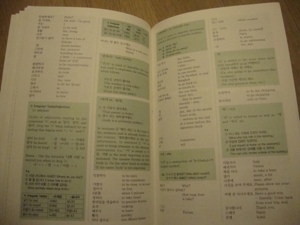
Notice the little green boxes; they are used to highlight little additional explanations about irregular verbs, honorifics and the like.
Last but not least, there is a dictionary with all of the words sorted alphabetically.
Can I use these books when studying alone? I don’t follow a class…
I don’t follow a class and I use these books as a base-line for my self-study. Why I chose the Sogang books rather than some other system was because I happened to come across SOAS in London who use these books for their Korean classes and one of their teachers was kind enough to explain how much she would recommend me to go through in order to sit the TOPIK successfully.
You are probably going to miss out on the games unless you have a friend who also studies Korean or you don’t mind playing against yourself.
I do try to rewrite the dialogues as recommended, I just write them directly in the student book rather than going through them with a fellow student.
I don’t follow only the Sogang series, I like to spice up my studies with material from other sources as well.
I think that Sogang and TTMIK supplement each other quite well, because in TTMIK you get a bit more explanation for each grammar point and the lessons are fun and engaging, but I have no clue how many TTMIK lessons I would have to go through to pass TOPIK level 3 whereas I have a pretty clear idea of how the Sogang books correspond to the TOPIK levels.
I hope this review gives you a better idea of what to expect from the Sogang series 🙂
If you have any questions or comments, write them in the comments section below 🙂
_ _ _ _
Added later:
Sogang’s estimate: study hours per set of books (student book and work book): 75-100 hours.
Good for self-learners:
ㅇ The vocabulary/grammar books make it easy to find grammar points you have looked at before.
ㅇ The vocabulary/grammar books are easy to bring with you so you can bring books for the previous levels with you when you move on to the next level.
ㅇ The work books introduce additional vocabulary in the exercises. This means that the form of the exercises are similar to the student book, but you also learn something new in the work books.
Potential difficulties for self-learners:
ㅇ Lack of answer key from level 2. For the dictations and listening exercises this would be really nice. The answers for the other types of exercises you can fairly easily double check with the pages in the student book.
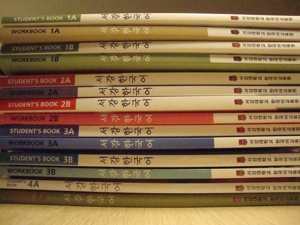
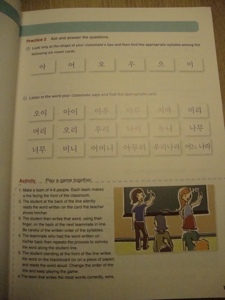
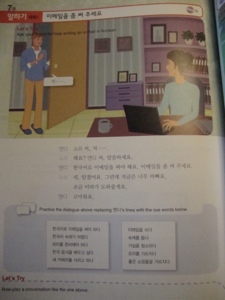
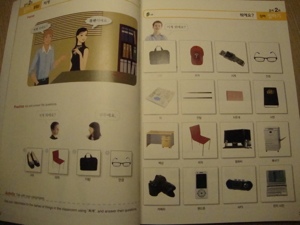
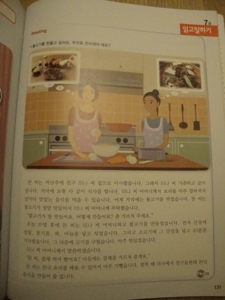
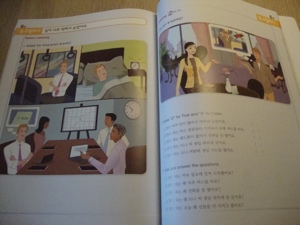
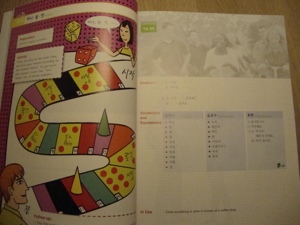
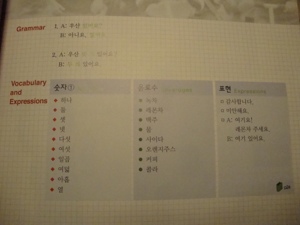
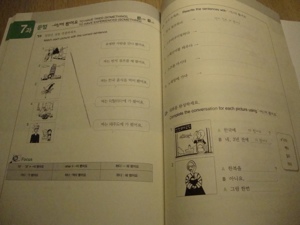

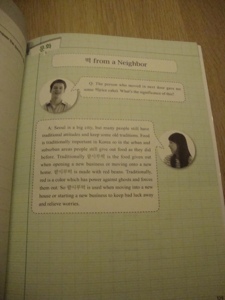
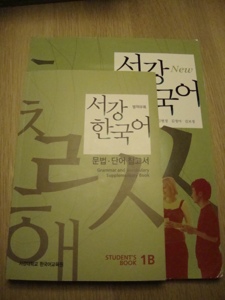
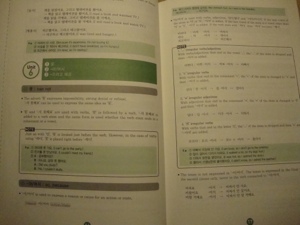
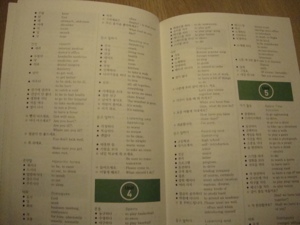
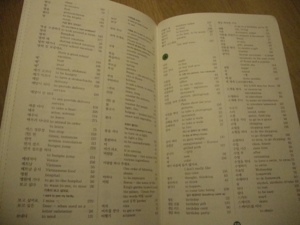
Reblogged this on Faith In Korean and commented:
For anyone who is curious about the Sogang series. I may or may not be buying this series.
Thank you for the thorough review. I believe there are 쓰기 books, too? Saw it on Hangul Park website.
I’m glad you found it helpful 🙂
You’re right! I didn’t even know that those books existed! It seems that there are two of them. I cannot see how they are structured, though.
wow!!! I’m so jealous of your Sogang book Collection ^^
Hehe most of them are gifts from my parents ^^ I like that they go about topics in a very “orderly” way. Do you have some of the books too?
im trying to buy the sogang book series but ttmik stopped selling and amazon to expensive any ideas where your folks get them? i saw hanbooks but that was the full korean version not the version for english learners.
TTMIK stopped selling them? Wow, they just added the fourth level recently if I remember correctly.
I got most of my books from SOAS in London because we “were in the neighbourhood”. I’m not aware of how the price compares to Amazon, but I have to admit they are also a bit pricy in UK.
From 2A and onwards, the books are in Korean only except for time indications in grammar questions whereas 1A&B are English/Korean. Which level are you looking for?
all really, i used to own the books but they got destroyed in a fire.
TTMIK said they had to take them down for now, nothing else was said
I’m so sorry to hear that 😦
If you are based near London, physically going to the SOAS store is definitely the easiest/cheapest. The books are fairly dense and shipping is calculated by weight. They also ship abroad if you are not based in UK, but you would have to contact them to get an actual quote for the total price. I once called them to ask about shipping, and they said that shipping to Denmark (which is where I live) would cost approximately £7 per set of books so I bought them when I happened to be in London anyway.
You can contact them here:
Telephone: +44 (0)20 7898 4470
E-mail: bookshop@soas.ac.uk
Try twoChois if you can use PayPal http://www.twochois.com/ They’ve got all kinds of Korean textbooks and you can make requests for any Korean books there.
I love you, i just rebought all my books from level 1A to 5B + a dictionary and 10 notebooks for 360 USD incl. shipping :D. thats 30 books cheapest i ever gotten them.
I wish I had money to buy all of the books in this series in one purchase but, im not that rich haha. Would you mind providing a list of grammar points for 2A and 2B? I’m not sure which one i should get but I know I’m in level 2.
Most of the grammar points in 2A are covered in TTMIK level 3 so that should give an indication of whether you’ve covered it already 🙂
I think there are a few that are introduced in Sogang but not in TTMIK level 3. That I will have to look into in the weekend once I come home from work 🙂
Thank you :]
It’s not possible for me to do a complete list of the grammar in the level 2 Sogang books, so here is a comparison based on the TTMIK system. I completed Sogang 1B and until TTMIK level 3 before sitting the TOPIK. Of course the systems are not 100% comparable, but I believe it’s a reference point for most of us 🙂
Grammar found in 2A that I did *not* encounter in TTMIK up to and incl level 3:
– 아/어 드릴게요
-이/가 아니에요
– 을 때 (I think)
– 으나까
– 다가
– 기로 했어요
– 읍시다
– 아/어 도 되요 (I think this is in the beginning of TTMIK level 4)
– 아/어 드릴까요?
– 아/어 주시겠어요
– 다고 하다
– 는다고 하다
– ㄴ/는다고 하다
– 이라고 하다
– 았/었다고 하다
That means that there are quite a few points in the 2A that I haven’t been through in the TTMIK system, but some of them I have encountered through my language exchanges or through watching dramas and listening to the dialogue like I was getting paid to do it.
If you know all of these or the vast majority of them, I would recommend you to get 2B 🙂
How to get the answer keys for the Sogang books? And can I know that in which level the grammar for 은/는요 is written in?
For the exercises that have answer keys, you will find them in the back of the book. For those that do not, the answers in the workbook can usually be found more or less directly in the student book (e.g. insert correct verb).
I would have to double check with the 는요 question, but I think it doesn’t have a lesson to itself. If I’m not mistaken it is introduced in 1A or 1B where it is used in practice in a sample dialogue and then the usage is explained quickly through a little text box in the margin of the page… I will double check.
Thanks! And I love the blog 🙂
the answer key for the all the workbooks till level 4 can be downloaded from the sogang klec website: https://klec.sogang.ac.kr/root/index.php
Thank you for sharing that link!
hye 🙂 I want to learn korean languange. im a new beginner with only knowledge of hangul alphabet. may i ask for your opinion? i want to buy good book as i’ll b self learner. are there any books you would highly recommend for me? thank you for your help ^^
It’s the best to start with a book developed by a korean university or written by a korean uni language centre as it provides the words and grammars needed for daily life. These kr uni textbook also covers TOPIK syllabus that is a proficiency in korean. Hence studying these textbooks is a great start as it goes by different levels. FYI I started with Sogang Korean Student Book.
It’s the best to start with a book developed by a korean university or written by a korean uni language centre as it provides the words and grammars needed for daily life. These kr uni textbook also covers TOPIK syllabus that is a proficiency in korean. Hence studying these textbooks is a great start as it goes by different levels. FYI I started with Sogang Korean Student Book. U could also check other textbooks from Yonse, Seoul or Ewha.
ok thanks for help 🙂
I see that Musical Arts has already answered your question 🙂 best of luck with your studies 🙂
Hi there! I found this review really helpful. Thanks for writing it.
Could you please tell me how many vocabulary items are covered in each textbook? In particular, how many vocab items are in book 1A? And 1B?
Hi and thanks for stopping by 🙂
You can find the new words in the booklet with grammar and vocabulary that comes with each set. I have to admit that I have never counted the number of new words, but in Sogang 1A, the glossary in alphabetical order takes up 10.25 pages (A5) and 1B has 14 pages (A5). I hope that helps! 🙂
Hi – I can’t seem to find the information on whether there are editions. My school requires me to purchase the 4th edition of the Sogang books. Are the ones you have here the 4th edition? If so, could you reply with a photo of the full cover of 1B and 2A?
Thanks!
Hi! I have just checked and I cannot see it anywhere in my books. It just says that the first version of the series was published in 2000 and that the “new series has been revised” according to suggestions from Korean teachers. Mine are from 2012, but it seems unlikely that nothing happened for 12 years. Maybe your school cooperates with a bookshop? Maybe you can find them there, see the covers of the books they have ordered, and then double check prices online 🙂